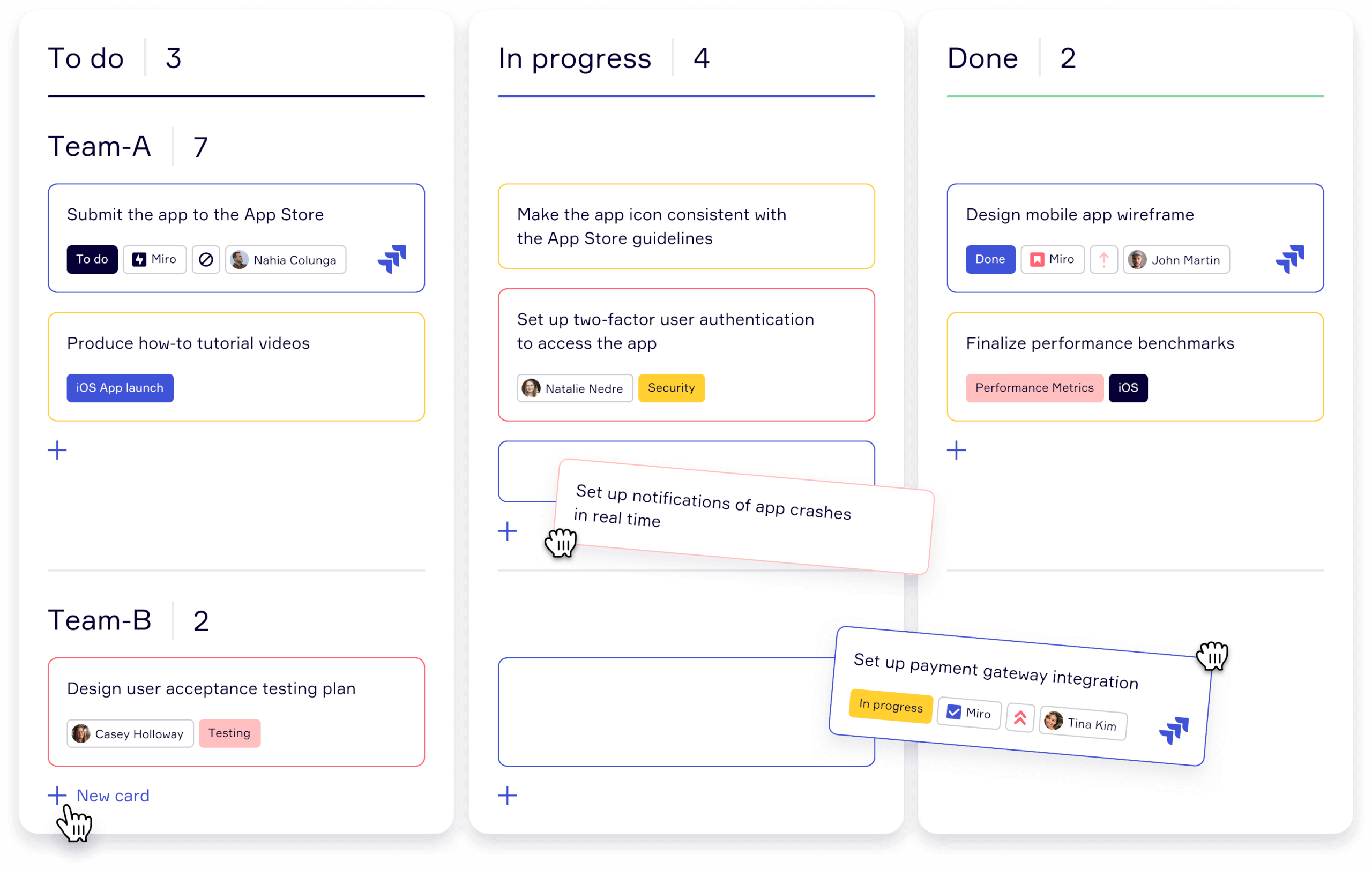At Blue Label Labs, we stand by select products like Miro because of their ability to enrich processes and furnish visual, collaborative tools that make our lives easier. We love using Slack for our day-to-day communications, but when it comes to intensive events like running design sprints, Miro is the centerpiece that brings our efforts together. It’s an excellent product, but it shines even brighter when effectively using plugins like Jira, which we will cover here.
What is Jira, and what role does it play in a design sprint?
If you’re reading, chances are you have some familiarity with the design sprint process developed by Jake Knapp at Google Ventures. We use this process at the start of virtually every new project to identify a solution to a problem or closely related subset of problems, brainstorm ideas, then build a prototype that we test extensively, which acts as the basis for the MVP we ultimately develop.
The Atlassian product, Jira, plays a key role in the testing phase near the end of the sprint. While there are many issue tracking products on the market, Jira is a workflow management platform that’s tailored for software development with built-in “boards” for agile methodologies like Scrum and Kanban. We don’t completely subscribe to any one particular methodology, and because every product we develop is different, we adapt Jira uniquely for each project.

During user testing, all kinds of information surface, from positive feedback to problems of various shapes and sizes. Certain issues that we encounter, specifically those that will persist outside of the prototype, are triaged then plugged into Jira where they are ranked using a prioritization process that systemically arranges bugs based on severity and priority. In addition to organizing problems for devs, Jira plays a key role by supplying an additional layer of transparency through Miro so everyone stays on the same page with other important tasks like core feature development.
Execute faster with Atlassian + Miro
Using Jira in Miro for building apps
When we start our projects, typically during the design sprint, a Miro board is created by the PM (Product Manager) to visibly layout everything for scoping, discovery, and planning. While software engineers typically sit out during the initial UX design phase and subsequent UI design process, the engineering lead (or TPM, aka Technical Product Manager) will take a look to provide input, ask questions, and create estimates or outline specs.
They will use this information to fulfill other responsibilities like developing architecture such as ER diagrams and API specifications in addition to researching third-party APIs. This allows our devs to warm up so when the time comes, they can hit the ground running.
Before pulling the trigger on development, developers refine and elaborate on details found on the Miro board then collaborate with the product team to make sure no stone is left unturned. Once there is a clear understanding of all matters uncovered during the design sprint, the PM creates Jira tickets for the dev team, complete with all information needed to build each element.
Jira will house all of the assigned dev tickets that will consist of feature descriptions and related specs and designs. As the dev teams engage with Jira elements — for example, changing a ticket status from “In Progress” to “Done” – it will be updated the system as well as displayed on the Jira card attached to the Miro board for all to see.
Profile
Blue Label Labs
is a digital product agency. They transform businesses through strategy, design and development of new and existing products. Over the past years, they have launched over 200 products across Android, iOS, and Web platforms.
FOUNDED IN: 2011
HQ: New York City
NUMBER OF EMPLOYEES: 64

One of the main reasons using Jira in Miro is so helpful is because of the value a well-designed board can provide when it comes to understanding progress. A list of tickets doesn’t do a project justice, especially when it’s a tall order that requires complex systems to come together in harmony. Miro provides a visual representation of what we are building that Jira further augments by providing a highly visible interface to ask questions and get clarification.
This is because the crux of an MVP is delivering a refined solution that’s functional enough for users to continue engaging with the product so that you can test it. Your goal is to trim every bit of fat you can — the board can help teams visualize elements that might extend beyond solving the core problem, thus preventing them from focusing on unnecessary development tasks. Once core development tasks are complete, the QA team’s observations will alter the board by bringing attention to issues.
As I alluded to earlier, an issue will have assigned priority and severity values that aren’t mutually exclusive. On its own, Jira only provides so much context through sorting and filtering features — yet, when Jira cards are arranged appropriately on a Miro board, the position can provide more meaning. Here, Jira tickets can reveal how problems fit into the grand scheme of the entire project and ultimately weed out workflow issues that stem from conflating priority and severity.
Final thoughts
At the end of the day, it’s all about the timely delivery of a product such that a company can begin building momentum in the market. It comes down to finding a balance between minding deadlines, offering features, and clearing out the most significant issues. Using Miro and Jira together, we’re able to stay on task and polish products accordingly before shipping them off to the market.


